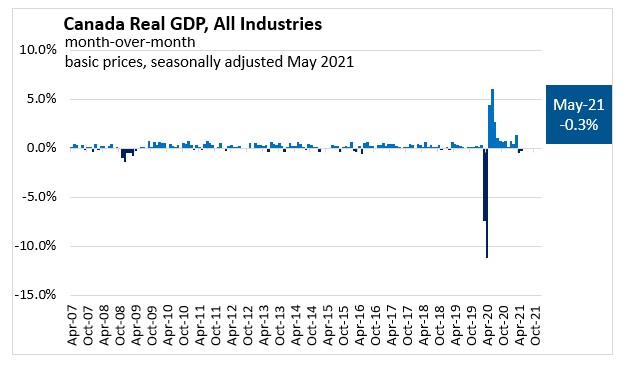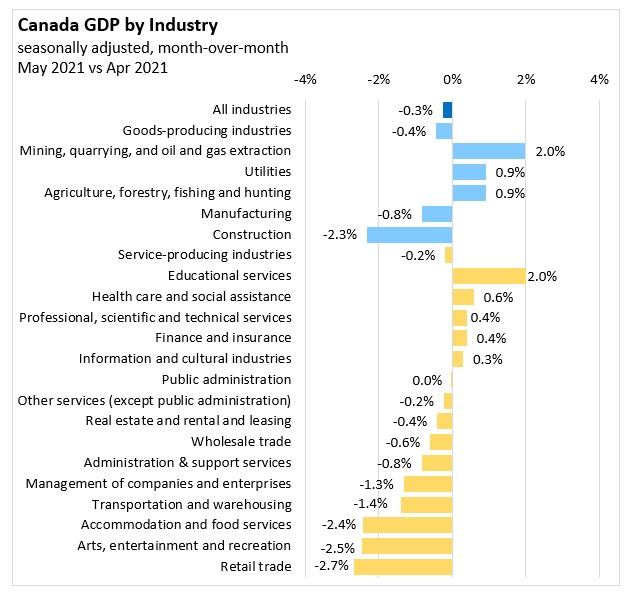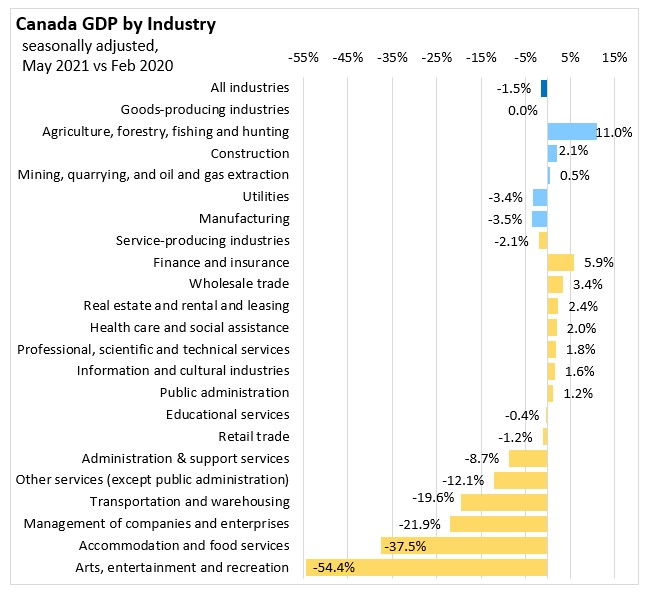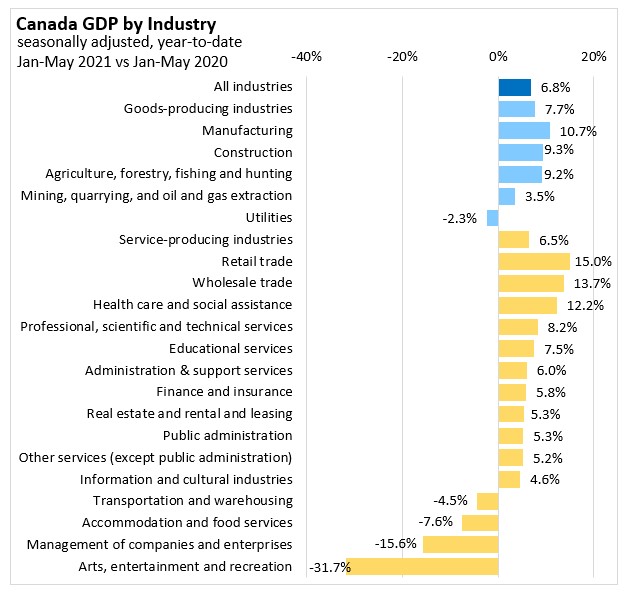For additional information relating to this article, please contact:
July 30, 2021CANADA GDP BY INDUSTRY, MAY 2021 With May reference month results, year-over-year (May 2021 vs May 2020) and year-to-date (Jan- May 21 vs Jan- May 20) are showing the rebounds in economic activity from the unprecedented declines observed at the start of the COVID-19 pandemic.
Real Gross Domestic Product (GDP) in Canada declined 0.3% in May 2021, following a 0.5% decline recorded in April 2021. The monthly decline was due to contraction both in service-producing industries (-0.2%) and goods-producing industries (-0.4%). Overall, 12 of 20 industries were down.
The Canadian economy was 1.5% smaller when compared to pre-pandemic February 2020 with an annualized value of $1,971 billion (chained 2012 dollars) in May 2021.
Statistics Canada’s preliminary estimate for real GDP points to an approximate 0.7% growth in June 2021 and a 0.6% gain in the second quarter of 2021. Easing of public health measures in many provinces in June supported growth in retail trade and accommodation and food services sectors. Manufacturing, mining, quarrying, and oil and gas extraction also showed increased activity while construction and wholesale trade contracted. The official GDP data for June 2021 and Q2 2021 will be published on August 31, 2021.


Goods-Producing Industries
Goods-producing sector output declined 0.4% month-over-month in May 2021. Higher activity in mining, quarrying and oil and gas extraction, utilities and agriculture, forestry, fishing and hunting was not able to fully offset the declines seen in construction and manufacturing.
Construction activity was down 2.3% in May following increases in the previous five months. Residential building construction declined 4.2% posting the first decline since November 2020. May’s decline was primarily driven by lower activity in single-family homes construction and in alterations and improvements. Non-residential building construction increased 0.1% supported by gains in commercial and institutional building construction.
Manufacturing real GDP declined 0.8% in May. Durable manufacturing declined 0.8% mostly due to declines recorded in fabricated metal product (-3.4%) and machinery (-2.6%) manufacturing. Activity in non-durable manufacturing (-0.9%) also declined with lower activity in food (-2.5%), chemical (-3.2%) and petroleum and coal product (-2.0%) manufacturing.
Mining, quarrying and oil and gas extraction increased 2.0% in May with gains in all three sub-sectors. Oil and gas subsector increased 2.6% in May posting the third consecutive gain. This was driven by a number of facilities and sites increasing production after some worksites in the Regional Municipality of Wood Buffalo in Alberta experienced COVID-19 outbreaks and lowered or suspended production in April. Mining and quarrying (except oil and gas) rose 0.3% in May, growing for the sixth time in the last seven months.
Utilities real GDP was up 0.9% in May, led by higher electric power generation, transmission and distribution, as well as natural gas distribution.
Services-Producing Industries
Output of services-producing sector declined 0.2% in May 2021.
Accommodation and food services declined 2.4% in May following a 4.3% decline in April as lockdown measures were reintroduced in many parts of Canada to contain the third wave of COVID-19 outbreaks. Food services and drinking places was down 1.3% while accommodation services declined 5.3%.
Retail trade activity declined 2.7% in May with declines in 9 of 12 subsectors. Lockdown measures restricted retail activity. Building material and garden equipment and supplies (-9.5%), motor vehicle and parts dealers (-3.5%), clothing and clothing accessories (-7.6%) and other traditional brick-and-mortar stores that rely more on in-store traffic stores posted the largest declines.
Wholesale trade was down 0.6% in May following growth in the previous two months. Gains recorded in machinery, equipment and supplies (+1.3%) and food, beverage and tobacco (+2.4%) were more than offset by declines seen in building material and supplies (-4.5%), personal and households goods wholesaling (-1.8%).
Real estate was down 0.4% in May following a 0.8% decline in April. Statistics Canada noted that this was the first back-to-back decline in the sector since March-April 2020. Home resale activity slowed in the majority of urban centres in May.
Public sector (educational services, health care and social assistance, and public administration) grew 0.7% in May. Educational services increased 2.0% in May led by growth in elementary and secondary schools. This was mainly due to activity returning to normal levels following the Government of Ontario’s decision to move spring break from mid-March to mid-April.

May 2021 vs February 2020
Canadian real GDP was 1.5% lower when compared to February 2020.
Amid the COVID-19 pandemic and economic recovery, the largest declines in activity have been in arts, entertainment and recreation (-54.4%), accommodation and food services (-37.5%) and management of companies and enterprises (-21.9%). Activity increased the most in agriculture, forestry, fishing and hunting (+11.0%), finance and insurance (+5.9%) and wholesale trade (+3.4%) from February 2020.

Year-Over-Year (May 2021 vs May 2020)
Canadian real GDP was 14.6% higher than in May 2020.The largest rebounds, in percentage terms, have been in accommodation and food services, wholesale trade, and other services (personal, repair). Utilities and management of companies declined relative to April 2020.
Year-to-Date (Jan-May 2021 vs Jan-May 2020)
The Canadian economy in the first five months of 2021 increased 6.8% compared to the same period in 2020.
Compared to the same period last year, the largest increases in activity have been in retail trade (+15.0%), wholesale trade (+13.7%), and healt care and social assistance (+12.2%). Activity decreased the most in arts, entertainment and recreation (-31.1%), management of companies (-15.6%), and accommodation and food services (-7.6%)

Source: Statistics Canada, Table 36-10-0434-01 Gross domestic product (GDP) at basic prices, by industry, monthly (x 1,000,000)